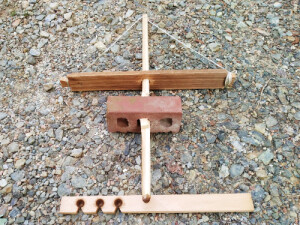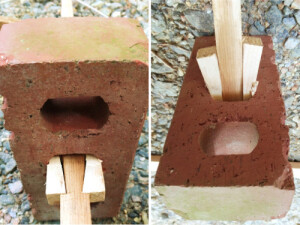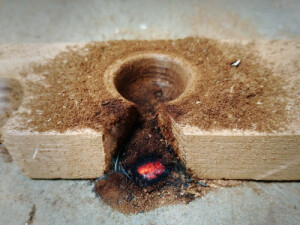 One of the most interesting fire by friction devices is the fire pump drill. Essentially it uses a long shaft as the spindle but incorporates a vertical moving handle with cordage attached at each end that is fastened to the top of the spindle (see photo). Just below the handle a flywheel is mounted on the shaft to aid in spinning the shaft once it is set in motion.
One of the most interesting fire by friction devices is the fire pump drill. Essentially it uses a long shaft as the spindle but incorporates a vertical moving handle with cordage attached at each end that is fastened to the top of the spindle (see photo). Just below the handle a flywheel is mounted on the shaft to aid in spinning the shaft once it is set in motion.
The action begins when the shaft is rotated by hand, causing the cordage to rap around the shaft which in turn lifts the handle with each wind of the cord. Once the handle reaches the top of the shaft both hands are used to grasp the handle to press down, causing the spindle to turn. Once the handle reaches the bottom of the stroke, the inertia of the flywheel continues to turn the shaft, thus rewinding the cordage and lifting the handle to the top. The cycle of pressing down the handle repeatedly keeps the shaft turning in alternate directions with each push until the resulting char and smoke is produced from the hearth board.
The most difficult element to construct on this device is the flywheel where wood blocks or stones have been used that usually needs some lashing or stone drilling. The purpose of this article is to offer a simple alternative for the first-time firecrafter when constructing a fire pump drill.
 I saw a three hole masonry brick that gave me the idea that the center hole would allow for a balanced flywheel. Without the need for lashing, I could use wedges of wood to attach it in place on the spindle shaft. By cutting notches below the brick it would hold the bottom two wedges in place while at the top an additional two wedges tighten the brick in place (see photo).
I saw a three hole masonry brick that gave me the idea that the center hole would allow for a balanced flywheel. Without the need for lashing, I could use wedges of wood to attach it in place on the spindle shaft. By cutting notches below the brick it would hold the bottom two wedges in place while at the top an additional two wedges tighten the brick in place (see photo).
To fasten the cordage to the handle I cut a joinery “dove tail” at each end, and for the spindle I cut a slit at the top of the shaft wherein I placed the middle strand of a “figure eight” knot while the rest of the knot encompassed the tip.
 It takes a little time to adjust to the rhythm of pumping the handle but once it flows and the resulting char and smoke begins to appear, the resulting ember makes it is a delight to perform.
It takes a little time to adjust to the rhythm of pumping the handle but once it flows and the resulting char and smoke begins to appear, the resulting ember makes it is a delight to perform.
via » Survivaltek at https://survivaltek.com

0 Comments